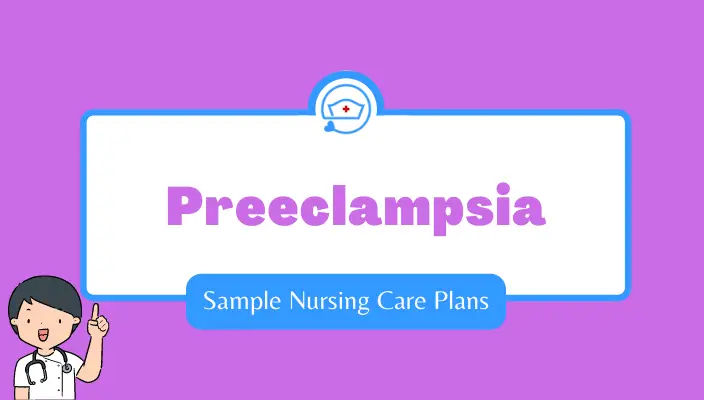Last updated on December 28th, 2023
Sample Nursing Care Plan for Preeclampsia
What is preeclampsia?
Preeclampsia is a multiorgan disorder that occurs after 20 weeks of gestation. It is characterized by high blood pressure with proteinuria.
Preeclampsia is triggered by placental and maternal vascular dysfunction. The symptoms of preeclampsia slowly return to normal levels after the delivery.
Every year, approximately 63000 maternal deaths are attributed to preeclampsia and eclampsia globally. Also, the perinatal mortality rate (PMR) from eclampsia in the US and UK ranges from 5.6% – 11.8%.
In this post, we’ll create a hypothetical preeclampsia case scenario and formulate a sample nursing care plan for a patient with preeclampsia.
Before starting with the case scenario and nursing care plan for preeclampsia, let’s quickly review the signs and symptoms and the complications of preeclampsia.
What are the signs and symptoms of preeclampsia?
- Pregnancy induced hypertension (PIH)
- Proteinuria
- Severe headache
- Blurry vision
- Abdominal pain
- Nausea and vomiting
- Oliguria
- Dyspnea
- Generalized edema
What are the complications of preeclampsia?
- Fetal distress
- Preterm birth
- Abruptio placentae
- HELLP syndrome
- Stillbirth
- Maternal death
- Intrauterine growth retadation (IUGR)
- Multiorgan damage
- Eclampsia – it is when the mother develops seizures due to uncontrolled high blood pressure. This is a life-threatening condition for the mother and baby.
Preeclampsia Case Scenario
Ms. Smith, 34-year-old, primigravida, on her 35th week of pregnancy, presented to the obstetric department with complaints of SOB, mild headache, nausea, +2 pitting edema of both lower limbs, and facial puffiness.
On examination, her BP was 170/90 mm Hg, oxygen saturation 98% in room air, pulse 118 bpm, RR 24 bpm, and temperature is 97 °F. Urine examination showed proteinuria +2. The FHR is 136 bpm, regular.
She denied any vision problems and epigastric pain. Her past medical history is insignificant and has no known drug allergies. Ms. Smith is admitted to the ward for treatment and continuous BP and fetal monitoring.
Case Discussion
Preeclampsia is defined as a new onset of hypertension (BP ≥140/90 mm Hg) and proteinuria (≥0.3g/24hours or ≥ 1+ on urine dipstick) or “the new onset of hypertension and significant end-organ dysfunction after 20 weeks of gestation or postpartum” in a woman who was previously normotensive.
As a nurse caring for preeclampsia patients, you should be on high alert and look out for signs and symptoms of severe preeclampsia that may progress to eclampsia. Following are the signs and symptoms of severe according to ACOG.
- BP ≥160/110 mm Hg (2 BP readings which is 6 or more hours apart while on bed rest)
- Proteinuria ( ≥5g/24hour urine specimen or ≥ 3+ on two random samples collected four or more hours apart)
- Oliguria ( ≤500 mL/24hours)
- Pulmonary edema
- Cyanosis
- Impairment of liver function
- Visual or cerebral disturbances
- Epigastric pain or pain in right upper quadrant
- Decreased platelet count
- Intrauterine growth restriction
In this case, the patient is just 35th week of gestation. This means the fetus is pre-term and won’t be fully developed yet. Therefore, our priority should be given to reduce blood pressure and restoring the hemodynamic stability of the mother.
If the mother’s condition stabilizes, the pregnancy can carry to the term. Because it will help to improve the cardiac output of the mother and optimize fetoplacental circulation.
However, any distress to fetal will require delivering the baby immediately. Depending on the condition of the mother and fetus, the delivery option will be deided. So, be prepared for that.
In addition, make sure that the patient’s partner or family members are well informed about the situation and need for delivery in case of emergency.
#1 Sample nursing care plan for preeclampsia – Decreased cardiac output
Nursing Assessment
Subjective Data:
- severe headache
- nausea
- breathing difficulty
Objective Data:
- Vitals: Blood pressure 170/90 mm Hg; RR 32 breaths/minute; HR 118 bpm; Afebrile; Spo2 96% in room air
- Tachypnia
- Tachycardia
- +4 pitting edema
- facial puffiness
Nursing Diagnosis [Decreased cardiac output]
Decreased cardiac output related to increased SVR secondary to preeclampsia, as evidenced by increased blood pressure (170/90 mm Hg), dyspnea, tachycardia, proteinuria, pitting edema of both limbs, and facial puffiness.
Goal / Desired Outcome
Short term: Patient will demonstrate normal cardiac output as evidenced by absence of dyspnea, normotensive status by the end of shift.
Long-term: The client will remain a normotensive and normal breathing pattern with reduced edema of the body, adhering to the treatment regimen for the rest of her pregnancy period.
Nursing Interventions with Rationales
| Interventions | Rationales |
| Monitor and document BP and pulse ever hourly or as needed | Hypertension results from biochemical changes that cause vasoconstriction and vasospasm. A sharp increase in BP indicate progression of preeclampsia |
| Measure urine output and proteinuria as per protocol | Elevated levels of protein in urine and decreased urine output indicates kidney injury and impending eclampsia |
| Maintain strict intake and output (I&O) chart | Hypovolemia and oliguria suggests renal hypoperfusion |
| Provide strict bed rest in lateral position. | Lateral position improves cardiac output by promoting venous return |
| Monitor electrolyte status and instruct the patient to reduce high sodium foods. | Increased levels of sodium increase water retention, thereby worsening the edema. |
| Administer antihypertensive medication as prescribed (for example; hydralazine, labetalol HCl, or methyldopa) | Antihypertensives lower BP by vasodilation and reducing systemic vascular resistance. |
| Prepare the patient and family for cesarean delivery if indicated due to the progression of preeclampsia or determined by the healthcare provider | Fetal and placental delivery ceases the progression of preeclampsia. Failed induction and/or attempt for vaginal delivery will lead to cesarean section. |
Related Nursing Diagnoses for Preeclampsia
- Risk for deficient fluid volume
- Anxiety related to fear of the unknown, threat to self and infant, new environment, hospitalization
- Death anxiety related to threat of preeclampsia
- Deficient knowledge related to lack of experience with situation
- Decreased diversional activity engagement related to bed rest
- Interrupted family processes related to situational crisis
- Impaired home maintenance related to hospitalization, bed rest
- Impaired physical mobility related to medically prescribed limitations
- Powerlessness related to complication threatening pregnancy, medically prescribed limitations
- Risk for disturbed maternal-fetal dyad related to interruption of bonding and attachment processes during separation from preterm and/or compromised newborn
- Situational low self-esteem related to loss of idealized pregnancy
Bonus Tips
As a nurse, you should be vigilantly monitoring the patient with preeclampsia and look out for impending signs and symptoms of eclampsia.
Here are some of the signs and symptoms that indicate the onset of eclampsia include:
- A sharp increase in blood pressure
- Diminished urine output (oliguria)
- Increase in proteinuria
- Severe persistent headache in frontal or occipital region
- Drowsiness
- Confusion
- Visual disturbances such as blurring of vision or flashing lights due to retinal edema
- Nausea and vomiting
- Epigastric pain
Also, it is an extremely stressful time for the mother-to-be and her family. So, therapeutic communication and compassionate nursing care are essential.
Conclusion
To recap, when planning nursing care for a patient with preeclampsia, the nurse must be on alert for worsening signs and symptoms. Because it would indicate imminent eclampsia which is life-threatening to the mother and baby.
Be ready to manage the emergency as pre-eclampsia can proceed to fatal complications including fetal demise. The ultimate aim of the nurse is to maintain hemodynamic stability. Thereby, improving the cardiac output of the mother to preserve optimal fetoplacental circulation.
Reference
Ackley, B., Ladwig, G., Makic, M., Martinez-Kratz, M., & Zanotti, M. (2020). Nursing Diagnoses Handbook: An Evidence-based Guide to Planning Care (12th ed.). Elsevier.
Konar, H. (2018). DC Dutta’s textbook of obstetrics. JP Medical.
Herdman, T., Kamitsuru, S. & Lopes, C. (2021). NURSING DIAGNOSES: Definitions and Classifications 2021-2023 (12th ed.). Thieme.
Jacob, A. (2018). Maternal and neonatal nursing care plans. Jaypee Brothers, Medical Publishers Pvt.
Swearingen, P. (2016). ALL-IN-ONE CARE PLANNING RESOURCE (4th ed.). Elsevier/Mosby.



Comments are closed.